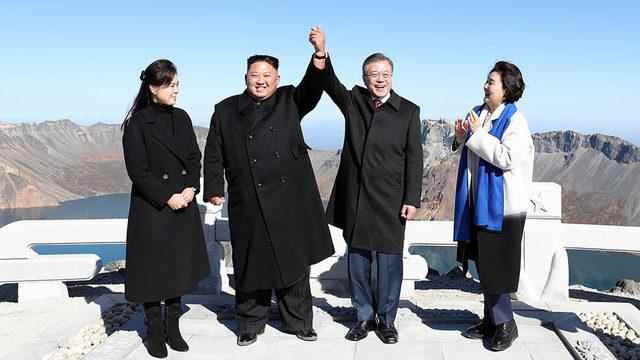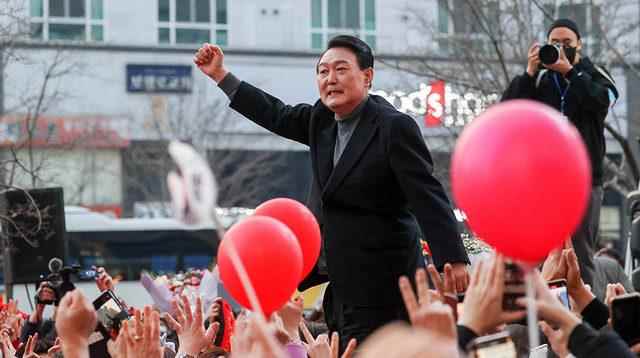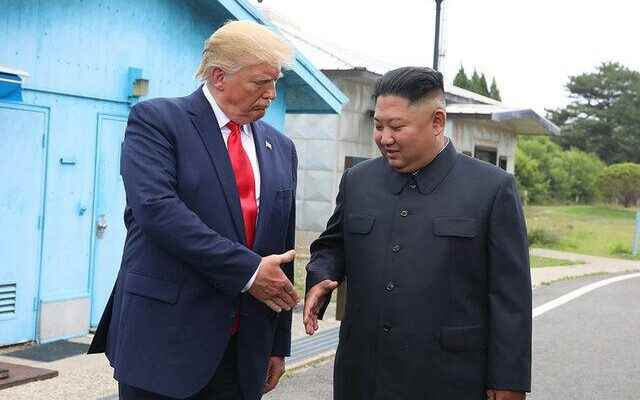In South Korea, as a new, hardline president prepares to take office, North Korean leader Kim Jong-un is testing his country’s weapons with even more haste. After failed nuclear talks and years of ceasefire, tensions are rising in the Korean Gulf.
“I thought about buying an ax but decided it would be difficult to carry, so I settled for the blade.”
Sitting late one night in the dimly lit cocktail bar, Jenn recalls her elaborate escape plan. As a South Korean living in Seoul, she knew what to do if the North attacked. First the guns, then two motorcycles, one for himself and one for his brother. Their parents would sit behind them. Thus, the North Koreans were considering quickly crossing the river in the city to get to the coast before the bridges were bombed and a port of hope was destroyed. One evening she and her brother sat down and charted their routes, agreeing to tie ribbons to trees in case they fell apart.
That was five years ago. At that time, North Korea was furiously testing missiles that could theoretically hit the United States, while then-US President Donald Trump was threatening to respond with “fire and fury”. Jenn admits she’s more anxious than most. But it was still the time many South Koreans felt closest to war since the war with North Korea ended almost 70 years ago.
Then something remarkable happened. South Korea’s newly elected president, Moon Jae-in, persuaded Trump to meet with Kim Jong-un. This is the first time an incumbent US President has met a North Korean leader. A series of historic summits followed, and hopes emerged that the North might be willing to give up its nuclear weapons and the two Koreas could make peace.
Excitement rose when South Korean leader Moon, the child of North Korean refugees, went to Pyongyang, the capital of the North, and held his opponent’s hand in a packed stadium. Moon’s advisor at that time, Prof. Moon Chung-in remembers that the crowd didn’t know what to do. This man was said to have enemies, but he had come to his land and offered peace. Suddenly, 150,000 North Koreans started clapping wildly. “It was great to watch, it was a very moving moment for me,” says the professor.

But hopes were dashed when President Moon left office. When the nuclear agreement between the United States and North Korea collapsed in 2019, talks between the two Koreas collapsed as well. A stalemate has been going on ever since. Meanwhile, North Korea continued to develop weapons of mass destruction and try again with alarming frequency. Only this time, the world’s attention was elsewhere because of the pandemic and now the war in Ukraine.
When asked whether the government had failed, Prof. Moon Chung-in gets defensive. “No, I don’t think so! Was there a war?” says.
In five years of one of the biggest crises in the two-Korean relations, Moon says his government has kept the peace. At the same time, he argues, the incentives show that they can bring North Korea to the negotiating table. He says the problem is that the North Korean negotiators are returning empty-handed, which is a great embarrassment to the government.
Former President Moon did his best to bring the North Koreans back to the table, but in the process he was accused of making concessions to one of the world’s most brutal dictators.

“I broke out in a cold sweat when I saw pictures of them laughing and crossing their arms,” Hanna Song recalls in her office in downtown Seoul.
His organization, the North Korean Database for Human Rights, has been monitoring North Korea’s human rights abuses for more than 20 years. The last few years have not been easy.
Hanna says human rights are Kim Jong-un’s Achilles tendon. He says President Moon “swept them under the rug” so as not to disturb the North Korean leader.

Hanna’s organization is holding talks with North Korean defectors at the relocation center Hanawon, where they spent their first three months in the country. Their statements play an important role in documenting human rights violations. Two years ago, however, the South Korean government cut off their access to the centre, so they were unable to collect evidence. Then Hanna began to hear from defectors being pressured not to speak publicly about their experiences in North Korea. Some received calls from the police assigned to adapt. “Do you think it’s wise to do that?” they were asking.
Hanna tried to force the government on the missing information. “What will you do if there is this gap in the evidence because you wanted Kim Jong-un not to be embarrassed in front of the international community? What happened in Ukraine is horrible, but at least we know,” she says.
Scary little is currently known about the latest situation in North Korea. The border closures that came with the coranavirus epidemic prevented people, and therefore information, from leaving the country. It is clear that Kim Jong-un continues to develop nuclear weapons, despite numerous international embargoes. In March, the regime tested an intercontinental ballistic missile for the first time since the summits began in 2018, and it flew longer and farther than in previous trials.

But now the hugs and handshakes are over. South Korea has elected a new, tougher-speaking leader. A former prosecutor with no previous political experience. In a recent interview, Yoon Suk-yeol declared North Korea the South’s “archenemy” and promised to take a tougher response to military tensions.
He said he would only meet with North Korea if it showed it was serious about denuclearization. But most experts now agree that North Korea has no intention of giving up nuclear weapons.
North Korea had already made this decision long before the Ukrainian war drew attention to the dangers of giving up such weapons, but of course the war situation didn’t help either.
Chris Green, adviser to the International Crisis Group, says this situation “cuts the chance of it working to zero” for Yoon’s strategy.

Yoon went so far as to say in his election campaign that if there are signs that the North will launch an attack, he might launch a preemptive strike on North Korea to destroy its weapons.
This is actually a long-standing part of South Korea’s defense strategy, and it’s clear that it will anger North Korea if it’s said so loudly.
It angered him. North Korea displayed its missiles in its latest show of strength. Wearing a white uniform, Kim Jong-un issued a stern warning: He said that any hostile force threatening North Korea “would not exist”. This was interpreted, in part, as a warning to South Korea’s new leader.

North Korea is developing a series of short-range missiles. It was hinted for the first time last month that these missiles could carry tactical nuclear warheads that could be used in a conventional war against South Korea. There are signs that one of these nuclear bombs will be tested.
But Chris Green still believes that North Korea’s main goal is to survive.
“If they use nuclear weapons in any way, it would mean the end of the regime,” he says. Instead, Green predicts that an arms race will begin between the North and the South, with both countries developing their inventories and experimenting more often. He believes that these will not cause war, but may lead to a miscalculation on both sides. According to Green, this is the biggest danger right now.
